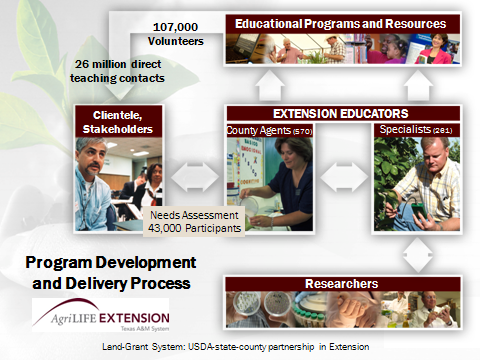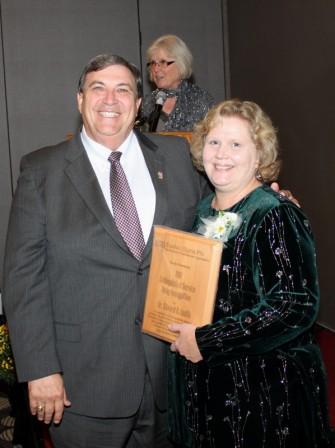
Figure 1.

I must say, I am very humbled that Epsilon Sigma Phi is recognizing me in this way. I especially appreciate that my colleagues in Texas nominated me. This is one of the most significant tributes I have ever received, and I will always treasure that it came from my Extension colleagues nationwide.
It's also humbling to speak before the other Ruby Award recipients who are here, not to mention two Texas directors I've worked for in the past. I would like to acknowledge Dr. Dan Pfannstiel, who was associate director when I was hired in 1975. He gave me my first specialist job in 1982, after he had become the agency director.
Also, Dr. Chester Fehlis, who was the Ruby Award recipient in 2004, brought me into Extension administration in 2001 and later promoted me for the position of director. I would like these two gentlemen to stand since I owe much of my Extension career to their guidance. I am honored by your presence and I thank you both.
My first job in Extension was as an assistant county agent in Gaines County, Texas. The objective for assistant agents was to work alongside an experienced trainer agent before being placed in another county as the lead agent. As I finished this process, I asked the Gaines County judge to write a letter of recommendation. I want to share excerpts from the letter, which the judge copied me on: "This letter is to recommend Edward Smith to anybody, anyplace, anytime for any kind of work supervision . . . He is probably the most efficient supervisor that we have ever employed in Gaines County. He loves to ride around in his pickup and tell others how to work . . . If the job needs to be done, he will go to great lengths to find someone to do it."
I tell this because any "roast" is based on some fact. It is true that I have depended on others my entire professional career. Just ask my administrative assistant; she will readily tell you I am high maintenance. The point is, I have always worked in a team setting. Any accolades given to me are only a reflection of the great people in the Texas AgriLife Extension Service, as well as the land-grant system across the states and territories. Of course, the person I depend on most of all is my lovely wife, Elaine, who has been my partner for 39 years. I could not have accomplished anything professionally without her steadfast support of our family; our two sons and daughters-in-law and four grandchildren.
Now, I would like to visit with you about the title of my presentation. I have read the last 10 years of Ruby Lectures and admire both the speakers and the points they made. However, I want to take a different approach. I just want us to be proud of "Extension," its legacy and its future. I think it is fitting as we begin to commemorate the 150th anniversary of the Morrill Act that we reflect on the significant impact that the legislation has had on the economic prosperity of this great nation.
The Morrill Act stated outright that higher education was no longer a luxury assigned to those who possessed great wealth, but would be available to all socio-economic classes and those who have the determination to succeed. The Hatch Act in 1887 established the basis for our Experiment Stations so that students could have cutting edge technology from which to build their individual wealth and that of the nation, both financial and social. This teaching and research model spread as land-grant status was conferred to historically black institutions in 1890. Teaching and research, however, were not sufficient to achieve the maximum potential of the Morrill Acts. And so Extension was institutionalized with the Smith Lever Act of 1914.
It was necessary to extend the science generated by our University Systems to the people as a way to give them ongoing access to cutting edge research and teaching, which are so important regardless of the times we are talking about. It was also necessary to provide societal feedback to the teaching and research functions of the university. These concepts were affirmed again in 1994, when land-grant status was given to tribal colleges.
I would argue that the 52-year evolution of the land-grant system from 1862 to 1914 led to impacts both nationally and worldwide that not only exceeded the economic and social goals envisioned by our forefathers, but are just as necessary today as any time in the past. It may be more so since the half-life of the technical knowledge from any academic degree is probably less than two years. Technology is increasing exponentially; society therefore is demanding to stay abreast and our land-grant systems are here to deliver on these consumer demands.
I titled this presentation "EXTENSION," in all caps, for a reason. All universities have teaching; all universities have research, and most have some form of outreach, but only land-grant university systems have "EXTENSION" in their mandate.
EXTENSION is not "service;" it is not "engagement;" it is not "outreach." If it were then every university would have in place all components of the land-grant system and therefore, the designation would recognize only a historical funding mechanism and not the institutional contract with society that continues to add significant value to this nation. We have land-grant system leaders who fail to recognize or uphold "EXTENSION," when it represents the only mission of land-grant systems that delineates their uniqueness. We must consistently market Extension and must never apologize for it.
In my opinion, the EXTENSION model is not a policy or a best management practice; it rises to the level of a principle. That means it is not defined by time. It worked in the 1800s and 1900s and is still applicable today. The basic program development and delivery process in Texas is illustrated by this figure. I'm confident that every state has their version of this program delivery model. I simply share the model I am most familiar with, which has helped Extension in Texas to address the critical needs of millions of people over the years.

Extension is a societal contract between local entities, the state and the federal government. Seaman Knapp recognized that the federal government could not just push new technology on society and expect it to be optimally adopted. You had to have buy-in from the local recipients and it had to be delivered by a credible source.
I believe this program development process is the essence of the Extension model that I refer to as timeless. It embodies the principles on which Extension is built. Therefore, I would argue that this process is valid across all states and territories, although the local partners may be defined differently.
Let's briefly review the program delivery model that I view as a "principle."
It all starts on the left, with the local constituency identifying the priorities that can be best addressed by Extension. In Texas, our local partners are the 254 county commissioners' courts served directly by our Extension county agents. Some 570 county agents and 260 specialists work with more than 43,000 participants at the county, regional and state level to identify the priorities that they feel will add economic value to the region.
So needs are identified by the people we serve; our agents and specialists also provide input into the process based on their expertise and training. If the issues are within Extension's mission and the research is currently available to meet the identified needs, the agents and specialists package the educational programs and deliver them to the clientele.
If the research is not available or is only partially available, then the agents and specialists work with research scientists to develop or enhance the necessary knowledge. Thus the model not only informs Extension, it informs the teaching and research functions as well.
It is not possible to reach millions of people in Texas through individual contacts by only 830 professional educators. Once our programs are developed, volunteers with unique subject-matter knowledge are recruited to help get the information out. The 107,000 volunteers in Texas contribute hours that equate to a full-time workforce of 1,774 to deliver Extension programming. Volunteers are a necessity and part of the Extension model from the beginning.
We are also adopting new tools such as eXtension. The social contract we have with the people includes an expectation on the part of our citizens that they have local access to Extension professionals. Many people also expect to be able to access us online. In today's world, our citizens expect to be able to engage with us both in local communities and via online communities.
There is no doubt in my mind that the Extension program development model can be classified as a principle that is timeless and unalterable. It will not work without the dedicated Extension volunteers, Extension professionals (agents), local leaders, and Extension specialists to apply science to the issues important to the people; or without research and teaching that provide objective science and train future leaders. Anytime a decision-maker thinks that a segment of the model can be done away, including the evaluation and feedback loop, they are wrong and the System will be significantly diminished if not destroyed. Remember, Extension is a principle not a best practice.
If the Extension education model is accepted as a principle, then what does this tell us about the skills and attributes that current and future land-grant leaders must possess to maintain positive impacts on our dynamic society? Legacy is a nice platform but we must continue to deliver in the future. Since I plan to be retired by next September, I have given considerable thought to the competencies a strong land-grant or Extension leader should possess.
In developing a list, I asked my senior leadership team to identify all the skills and attributes they think are important. Their answers totaled more than 60 items. Through a modified Delphi approach, we narrowed it down to 21. Believe me, this is not an exhaustive list or one that reflects my attributes, but it is one that I feel future leadership must possess, whether it is as Extension director, a land-grant university president, a land-grant chancellor, or any senior leadership team in our system.
I have divided the list into two categories. The first is a set of necessary attributes that all leaders should possess whether running businesses, universities, or Extension programs, etc.
| 1. Strategically oriented | 8. Skilled |
| 2. Economically, financially sound | 9. Willing to take manageble risk |
| 3. Able to manage complex issues | 10. Committed to diversity |
| 4. Politically astute | 11. Socially astute |
| 5. Decisive | 12. Acceptes, promotes new technology |
| 6. Delegates responsibility with authority | 13. Builds relationships |
| 7. Team oriented |
I doubt if these 13 attributes would surprise anyone in this audience. While these attributes are necessary for any leader, they are not sufficient for success by someone leading in the land-grant system.
I would argue that there are eight additional attributes, which are not just necessary, but are uniquely critical for success and must also be possessed by Extension and/or land-grant leadership. It is these eight attributes that separate successful programs from the rest of the pack. Therefore, it is these eight which I would like to further discuss.
1. Serves selflessly
2. Distinguishes Extension from outreach, engagement and service
3. Values and advocates for all land-grant components
4. Maintains the local program delivery network
5. Ensures an alternatives and consequences approach to Extension education
6. Values outside perspectives
7. Staffs leadership team with highly competent individuals, ready to step up
8. Devoted to leadership development
The first I would condense to "selfless service." That is, having the integrity and ethics to put the institution above personal matters or ambitions when making decisions. Effective leaders cannot focus only on positioning themselves for the next job. They can't make decisions based on what's popular within the institution or with upper level administration or their peers. They must do what is right for the institution after getting the views of trusted leadership.
Second, they must have a full understanding of "Extension" and what makes it unique; what makes it different from outreach, engagement and service. I have already expressed this, but it has to be there, inherent in their experience.
Third, they must value all components of the land-grant system, teaching, research and service in addition to Extension. In other words, they must understand that the value of the total system is greater than the sum of the parts. The partnerships that are unique to the land-grant model are vital to a successful system. We must show decision makers the value added by the system. Furthermore, in all venues, we must passionately support and interpret the relevance, value and impacts of Extension. We must avoid Extensionese and tell our story in a way that people understand…relating that Extension positively and significantly impacts jobs and dollars. We cannot sit back and let some leaders rationalize sending the Extension model into oblivion.
Fourth, as discussed previously, the model upholds local program delivery based on the priorities identified by the constituency. As we rationalize budget reallocation, many feel that the local presence is not necessary. This is an unfortunate position and will eventually collapse the entire Extension system. From a programming standpoint, the farther removed we are from the people we are serving, the less we understand their needs and how best to provide assistance. From a funding standpoint, local understanding and the political capital that this offers is crucial to Extension's future.
Fifth, we should not be prescriptive. We must deliver programs in an alternative and consequences approach. Families, businesses, communities, and state and federal governments are too complex to be prescriptive. We must deliver the best science with enough practical information that the decision maker can make an informed decision.
Sixth, no one has a lock on the best outcomes for the institution. We have to listen to all viewpoints. Remember the "alternative and consequences" approach. A decision will have to be made on key issues, but hopefully it will be an informed decision.
Seventh, the leader needs to surround himself or herself with individuals capable of taking over immediately. An Extension director should be the most dispensable person on the team.
The eighth and final attribute that I will discuss is a devotion to leadership development. Seven cannot happen if the institution does not have a professional leadership development process in place. One that identifies current and future leaders and puts them in a position that allows them to experience the reward of having responsibility and the authority to make decisions. Right or wrong, of course both will happen, leadership is forged in the arena.
Extension needs leaders with these critical attributes. Extension needs leader who understands its principles and will work tirelessly for the benefit of the great institution. The future of our country will be so much better for it.
 I want to thank Epsilon Sigma Phi for all you do and ask that you continuously challenge your colleagues and decision makers at all levels to tell the Extension story. Do not be apologetic for "Extension" or accept passively those who want to diminish its role in your various institutions. The model is sound, timeless, and much needed in today's complex world.
I want to thank Epsilon Sigma Phi for all you do and ask that you continuously challenge your colleagues and decision makers at all levels to tell the Extension story. Do not be apologetic for "Extension" or accept passively those who want to diminish its role in your various institutions. The model is sound, timeless, and much needed in today's complex world.
Thank you.